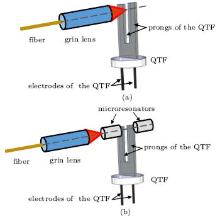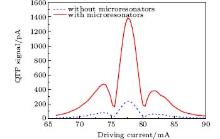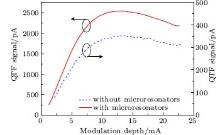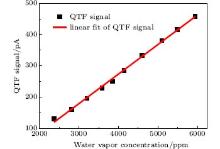Corresponding author. E-mail: xiel@semi.ac.cn
Project supported by the National Natural Science Foundation of China (Grant Nos. 61107070, 61127018, and 61377071).
A compact and highly linear quartz-enhanced photoacoustic spectroscopy (QEPAS) sensor for the measurement of water vapor concentration in the air is demonstrated. A cost-effective quartz tuning fork (QTF) is used as the sharp transducer to convert light energy into an electrical signal based on the piezoelectric effect, thereby removing the need for a photodetector. The short optical path featured by the proposed sensing system leads to a decreased size. Furthermore, a pair of microresonators is applied in the absorbance detection module (ADM) for QTF signal enhancement. Compared with the system without microresonators, the detected QTF signal is increased to approximately 7-fold. Using this optimized QEPAS sensor with the proper modulation frequency and depth, we measure the water vapor concentration in the air at atmospheric pressure and room temperature. The experimental result shows that the sensor has a high sensitivity of 1.058 parts-per-million.
Water vapor (H2O) is the most variable element of the major components in the atmosphere. The humidity represents the concentration of water vapor in the air and is of great importance in diverse fields such as weather forecasting, environment monitoring, plant cultivation, industrial process control, and food processing.[1– 3] The conventional devices for measuring the water vapor concentration include mechanical hygrometers, [4] wet-bulb and dry-bulb thermometers, [5] dew point instruments, [6] and capacitance humidity sensors.[7] However, the mechanical hygrometers suffer from long response time and limited accuracy. The wet-bulb and dry-bulb thermometers have limited accuracy because of natural ventilation variations, which result in large measurement errors up to ± 5%. Under appropriate conditions, the dew point instruments have high accuracy, however their response time is typically 5 min or longer at the low dew point temperature. Although the reliability and the accuracy of the capacitance humidity sensors have been improved and the systems have become cost-effective, their capacitance is primarily a nonlinear function of the water vapor concentration. The temperature and the frequency of the capacitance humidity sensors are the other two major factors that considerably influence the capacitance.[8– 10] Tunable diode laser absorption spectroscopy (TDLAS) systems avoid the problems mentioned above, however, they often require complicated and delicate optical systems in order to increase their sensitivity, thus leading to an increase of their size.[11, 12]
Photoacoustic spectroscopy (PAS) is an attractive approach for photoacoustic detection of trace gases. In PAS, the absorbed laser energy by the target gas is transformed into heat via non-radiative processes. Subsequently, the heat energy results in an increase of the local temperature and pressure in the gas sample, which is known as the photoacoustic effect. Periodic optical absorption will generate a periodic acoustic pressure propagating in the sample as a sound wave, which can be detected with an acoustic transducer.[13] Recently, there has been a growing interest in quartz-enhanced photoacoustic spectroscopy (QEPAS) as a variation of PAS. QEPAS utilizes a quartz tuning fork (QTF) as the resonant acoustic transducer, which was first proposed by Kosterev et al. in 2002.[14] QEPAS is widely used in trace gas detection, such as methane detection and acetylene detection.[15, 16]
In this paper, we apply the QEPAS technique to the humidity measurement at atmospheric pressure and room temperature, demonstrating an optimized QEPAS sensor with a pair of microresonators for detected signal enhancement. Compared with the traditional methods for the measurement of water vapor concentration, the QEPAS sensor has high linearity and sensitivity, short response time, short optical path, as well as low cost.
The configuration of the QEPAS sensor for the measurement of water vapor concentration in the air is illustrated in Fig. 1. We employ a distributed feedback (DFB) laser diode operating at ∼ 1370 nm as the light source. The temperature and the driving current of the laser diode are controlled by a laser driver. An acoustic pressure wave is generated when the optical radiation is absorbed by the ambient water vapor. It excites a resonant vibration of the QTF. Finally, the light energy is converted into a piezoelectric current signal by an absorbance detection module (ADM). Here the ADM plays an important role as a photodetector while it costs much less. The piezoelectric current is induced only when the QTF prongs bend in opposite directions. The beam passing through the gap of the QTF contributes to efficient excitation of the vibration. Vibrations from distant sources tend to move the QTF prongs in the same direction, which causes no electrical response.[17] The weak QEPAS signal is detected by a lock-in amplifier, whose time constant is set to 500 ms. The sensing system is equipped with a personal computer (PC) to control the instruments and log the acquired data via a GPIB interface. A function generator provides two signals with the same frequency and equal power; one serves as the reference signal for the lock-in amplifier, and the other is used as the modulation signal of the laser driver.
In the QEPAS sensor, light from the laser diode is coupled into the ADM architecture through a single mode fiber (SMF). The optical energy is transformed into an electrical signal, which can be extracted from the electrodes of the QTF. In the sensing system, a pair of microresonators is used in the ADM for QTF signal enhancement. We also provide the ADM architecture without microresonators for comparison (Fig. 2). Both architectures remove the need for a long optical path to enhance the detected signal. The optical path of the basic ADM architecture without microresonators equals to the thickness of the used QTF, which is typically ∼ 0.3 mm. When a pair of 4.45 mm long microresonators is introduced, the optical length is still less than 9.3 mm. Light from the DFB laser diode is focused through the gap between the two prongs of the QTF by a Grin lens. The resonant frequency of the QTF is ∼ 32.768 kHz (i.e., 215 Hz) in vacuum. Both its resonant frequency f0 and quality factor Q are dependent on the QTF temperature and the surrounding gas pressure when exposed to ambient atmosphere.[17]
The wavelength modulation (WM) technology and the second harmonic detection technology are adopted in the QEPAS sensing system.[18] The water vapor interacts with the light emitted from the laser diode when the central wavelength of the light source is locked to a strong absorption line of water vapor. The Beer– Lambert law gives the relationship between the transmitted intensity It and the incident intensity I0[19]
 |
where α , C, and L are the absorption coefficient, the volume fraction of water vapor, and the thickness of the QTF, respectively. In the sensing system, α CL ≪ 1, therefore
 |
The absorbed intensity I is given by
 |
The vibrational– translational relaxation is so instantaneous that the absorbed light energy is completely converted into heat energy, which indicates[20, 21]
 |
where k is Boltzmann’ s constant, Δ T is the variation of the gas temperature, N is the gas number density, V is the gas volume, H is the output power of the DFB laser diode, and t is the time. According to the ideal gas law, the relationship between the variations of the pressure and the temperature is
 |
therefore
 |
where Δ P represents the acoustic pressure difference, which is followed by the generation of a sound wave; and A is the effective cross section, which should be approximately equal to the square of the QTF gap. A periodic sound wave is acquired when the light source is modulated by a sinusoidal signal at half of the resonant frequency of the used QTF. In QEPAS, a QTF is used to accumulate energy instead of an acoustic resonator. As is known from the classical oscillator theory, [22]
 |
where Q and f0 are the quality factor and the resonant frequency of the QTF, respectively. The sound wave causes a resonance of the QTF prongs, and the detected signal S is given by[17]
 |
When the sensor is applied to the humidity measurement at atmospheric pressure and room temperature, H, α , Q, A, and f0 are constants. Hence, S is proportional to the concentration of water vapor in the air.
Based on the principle of the QEPAS sensing system described above, there are two key factors that decide the performance of the proposed sensor system. Firstly, the central wavelength of the light source has to be fixed at a strong absorption line of water vapor. We refer to HITRAN database when selecting the absorption line and lock the central wavelength to the absorption line by laser wavelength scanning.[23] Secondly, the modulation frequency and the modulation depth should be optimized. We apply the sensing system to the measurement of water vapor concentration in the air and study its linearity and sensitivity where the two key factors mentioned above are optimized. To evaluate the characteristics of the sensing system, experiments are performed at different measurement modes as shown below.
In the QEPAS sensing system, the central wavelength of the light source should be locked to a strong absorption line of water vapor within its tuning range by controlling the laser temperature or driving current. The dependences of the central wavelength of the laser on the temperature and the driving current are measured for our system. It is found that the central wavelength of the laser diode is linearly related to the temperature with a constant of 0.1 nm/° C. Similarly, the wavelength tuning coefficient of the laser current is found to be 0.005 nm/mA. Therefore, we use the laser temperature to do the coarse tuning and then vary the laser driving current for the fine tuning. The wavelength of the used DFB laser diode can be tuned around 1370 nm.
We scan the laser driving current so that the central wavelength of the laser scans across the water vapor absorption line. The modulation frequency is fixed at half of the individual resonant frequency of the QTF. The double-frequency QTF signal with the microresonators as a function of the driving current of the laser is shown in Fig. 3. For comparison, the double-frequency QTF signal without microresonators for the same water vapor concentration and with identical modulation depth is also shown. The profiles of the two lines agree well and the amplitude of the signal enhances about 7 times by the microresonators. The optimum driving current is 77.6 mA.
We set the driving current of the laser to the optimum value and scan the modulation frequency for both configurations with and without the microresonators. The obtained QTF signals are plotted in Fig. 4 as a function of the modulation frequency. The QTF signals of the two configurations are also detected for the same water vapor concentration and with identical modulation depth.
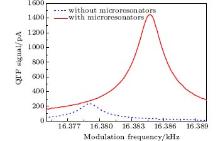 | Fig. 4. Double-frequency QTF signal as a function of the modulation frequency. The laser temperature is set at 31 ° C. The output power of the DFB laser diode is 7 mW. |
The utilized QTFs have extremely similar resonant properties except slightly different resonant frequencies. The maximum of the curve, I(f0), is acquired when the modulation frequency equals to the resonant frequency of the QTF f0. The quality factor of the QTF, Q, can be calculated by
 |
where Δ f is the width of the resonant curve at the 
Furthermore, we vary the modulation depth with the driving current of the laser at the optimum value of 77.6 mA and the modulation frequency at the resonant frequency of the QTF. The QTF signals of the architectures with and without the microresonators varying with the modulation depth are shown in Fig. 5. It is noted that the signal profiles are consistent with each other and they both reach their maxima at the modulation depth of 12 mA. The QTF signals increase dramatically when the modulation depth varies from 2 mA to 12 mA and then drop slightly after that. While the microresonators strongly enhance the QTF signals as we observe in the laser central wavelength scanning by the driving current.
The performance of the QEPAS sensor has been fully optimized by the employment of the microresonators, as well as an appropriate choice of the laser driving current, the modulation frequency, and the modulation depth in the above sections. In this section, the results of the measurement of water vapor concentration in the air by using the developed QEPAS sensor at atmospheric pressure and room temperature are given. The architecture with the microresonators is used. The laser driving current is set to 77.6 mA. The modulation frequency and the modulation depth are 16.3846 kHz and 12 mA, respectively.
The dependence of the obtained QTF signal on the water vapor concentration is plotted in Fig. 6. It is observed that the QTF signal is proportional to the water vapor concentration in the air. Therefore, the sensing system has a high linearity for the measurement of water vapor concentration. The lock-in amplifier (Model 7280) is used to record the QTF signal. The sensitivity of the QTF signal is 0.1 pA when the data acquisition is processed. The sensing system reaches a sensitivity of 1.058 parts-per-million (with a 500 ms lock-in time constant) according to the linear fit line with a slope of 0.09449.
A QEPAS sensor is demonstrated for the measurement of water vapor concentration in the air at atmospheric pressure and room temperature. It has advantages over the traditional sensors, including high accuracy, good sensitivity, and large dynamic range. In addition, it has a short optical path and the ADM can be integrated in a very small volume. The QEPAS sensor is very cost-effective since a QTF is used to convert light energy into an electrical signal instead of a photodetector.
Two architectures of ADM with and without microresonators are proposed for comparison. We investigate the effects of the laser driving current, the modulation frequency, and the modulation depth for the two architectures. The profiles of these properties agree well with each other while the detected QTF signal is enhanced 7 times by using the microresonators. The sensing system with the microresonators is applied to the measurement of water vapor concentration in the air at atmospheric pressure and room temperature. The sensing system obtains a good linearity with a sensitivity of 1.058 parts-per-million.
| 1 |
|
| 2 |
|
| 3 |
|
| 4 |
|
| 5 |
|
| 6 |
|
| 7 |
|
| 8 |
|
| 9 |
|
| 10 |
|
| 11 |
|
| 12 |
|
| 13 |
|
| 14 |
|
| 15 |
|
| 16 |
|
| 17 |
|
| 18 |
|
| 19 |
|
| 20 |
|
| 21 |
|
| 22 |
|
| 23 |
|



